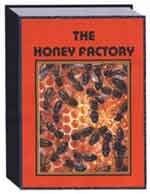|
SITE
INDEX
QUICKENING
NEWS
PREPARATIONS
1.
Food
2.
Manna
Meals
3.
Water
4.
Sanitation
5.
Medical,
health
6.
Kerosene heaters and cookers
7.
Lighting
8. Wood
cooking and heating
9. Communi-cations
10. Essential
Tools
11. Home
built items
12.
Electrical; generators
and power
13. War
preparedness
14.
Gardening
SITE
INDEX
Miles Stair's SURVIVAL
SHOP
HOME
RADIATION
INDEX & JET STREAM
PROPHECY
COMMENTARY
BY MILES
BOOKLETS
BY MILES
GUEST
SUBMISSIONS
PHOTO
INDEX
LINKS
SITE
INDEX
Miles Stair's
SURVIVAL
SHOP
|
|

IMPORTANT DATES IN BEEKEEPING
-
2600
BC Egypt: Knew
how to smoke bees using earthenware pipes and remove
honeycomb.
-
340
BC Aristotle s "Historia
Animalum" discussed floral fidelity, winter feeding,
the fact that bees assume different tasks at different
stages of adult life, and mentions foulbrood
disease.
-
25 BC
Virgil (Roman) told about placing hives out of the wind
and away from livestock, and the importance of a clean
water supply.
|
 |
My book "The Honey Factory"
is now available as a downloadable
eBook! Updated, with many full color
photos.
"I
find the depth of information contained
staggering, this book would be beneficial for
anyone starting out with bees, right through to
the more experienced beekeeper. It contains
diagrams, drawings, photos, personal stories on
beekeeping, hints, ideas, thoughts, an annual
diary, storage ideas and much much more. You
really do need to read the
list of chapters to get more of an idea on
what they are offering here in this
ebook." Robyn
Parry.
Click here to get your copy
now.
For a
printed or CD edition of "The Honey Factory,"
click here.
|
-
the sale of propolis for medicinal use.
-
60 AD
Comella (Roman) described beekeeping tools, including a
smoker and a hive tool very much like the ones used
today.
-
1400
Straw skeps introduced by Anglo Saxons, replacing
fragile pottery hives.
-
1650's Rev. William Mew
of Gloucestshire, England, built an octagonal hive and
supers from wood.
-
1675
John Gedde, a Scot, granted patent for a wooden hive
with removable inside frames.
-
1792
F. Huber of Geneva, Swiss, with his faithful servant F.
Burnens to do actual observations because Huber was
blind, did the first truly scientific observations of
honeybees. Huber discovered that bees can transform
worker eggs into queens, that a queen, not a king,
ruled the hive, that workers could lay eggs that would
hatch, that queens will fight, that queens mated in
flight, studied the causes of swarming, the use of
antennae, and the production of wax scales. Huber also
developed a "leaf" hive so that individual vertical
combs could be examined.
-
1851
Rev. Lorenzo Lorraine Langstroth discovered the concept
of bee space, realizing that honeybees will leave open
a space of 5/16", building burr comb in spaces over
3/8" and propolizing spaces 1 /4" or less. Langstroth
developed the 10 frame "deep" hive with moveable frames
as used today. Langstroth' s discoveries enabled modern
beekeeping to take place on an economical basis.
-
1857
Johannes Mehring, a German carpenter, developed wax
foundations with octagonal indentations (5 per inch)
for use in Langstroth' s frames. With this development
straight combs could be assured.
-
1865
Abbe Collin built the first wire queen excluder.
-
1866
Major Franz von Hruschka of Austria developed the
centrifugal honey extractor, designed for the 10" x 10"
Austrian frames.
-
1868
A. J. Root designed a centrifugal honey extractor for
Langstroth frames, and put gears from an apple parer on
top, thereby giving geared leverage for ease of use.
Root's extractor was the first all-metal extractor.
-
1870
Moses Quinby of New York State developed the first
bellows-type smoker.
-
1891
E. C. Porter of Illinois developed the leaf-spring bee
escape, still in use precisely as designed by
Porter.
-
1896
E. B. Weed of New York State developed rollers for
imprinting a continuous sheet of wax foundation of a
uniform thickness. Previously, a wooden board was
dipped into molten wax, the wax allowed to cool, then
the sheet pulled away from the board.
-
1920's Root and Dadant
improve Hetherington's idea of wire reinforcing in the
foundation. Weed's thin foundation would often fail in
Root's and Dadant's extractors, and they were the
principal sources for wax foundation in America.
-
1919 Karl von
Frisch, of Germany, first published on beekeeping and
the scientific analysis of bee behavior. von Frisch
continued to study honeybees for 59 years, discovering
bee language as expressed in the "bee dance," plus
other discoveries which together were more than all
other scientific discoveries in history combined. For
his work von Frisch won the Nobel Prize in science in
1973.
|
|
|


